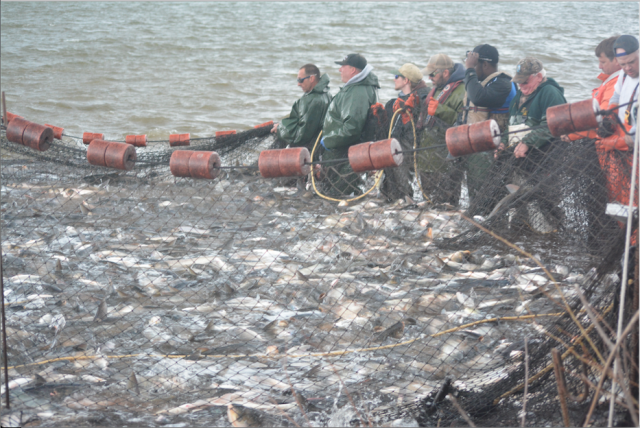
Newsroom
Oh, Carp.
 |
| A team of fishers and college students pull thousands of pounds of Asian carp out of a branch of the Illinois River, using a new fishing method in an attempt to slow down the invasion. [Image Credit: courtesy of Duane Chapman] |
On a cool morning in late March, eight small motorboats trundled into a quiet backwater branching off the Illinois River. They strung two nets behind them, to trap all the fish in the three miles of water now cut off from the rest of the river. Slowly, they moved toward the far edge of the backwater arm, dropping thousands of yards of nets as they putted along, dividing the now pseudo-lake into compartments along a 1.5-kilometer net they ran down the middle of the backwater. When they reached the back edge, the fishers turned around, revved their engines and started banging on the sides of their boats, shattering the quiet peace of the lake. In response, the fishers report, thousands of Asian carp fled the noise, swimming through the single hole left in the nets, leaving a single river segment totally carp free. The native fish, who hid from the noise instead of racing away, reclaimed the river segment in the carp’s absence. Over the next two weeks, the fishers drove the carp through the river, netting off the carp-free space behind them, in an attempt to catch all the carp in the river at once.
Asian carp were
While politicians and activist groups argue over
"It’s quite an undertaking, doing one of these,” says fish biologist
Asian carp outcompete native species by eating the tiny animals at the bottom of the food chain, cutting off the food supply to other fish. This leads to algae taking over waterways, degrading the rivers for aquatic life and recreational use. If they enter the Great Lakes, carp could
The most important physical structure between carp and Lake Michigan — the
But the carp aren’t waiting on Congress. The best bet right now to slow their continuing onslaught is to remove all the carp from the upper stretches of the Illinois River, says
While previous
And after catching nearly 100,000 pounds of carp in their first attempt with the Chinese technique, catching a million pounds might actually be a possibility once they have some more practice. Although it sounds extreme, a million-pound catch is what happens in the shallow lakes around the Yangtze River in China. Last summer, Chapman of the US Geological Survey noticed a passing mention to the Chinese Unified Method of fishing in a book chapter
Despite living thousands of miles apart, they discovered they shared a common language with their Chinese counterparts. “When you get a bunch of real fishheads in a room you almost don’t need a translator,” says Chapman. After talking through the method, they went out to one of the commercial carp lakes to watch the Chinese fishers, who harvest in the winter to take advantage of the fact that carp are
To use do this in the U.S., Chapman and Irons had to modify the method. American fishing regulations mean that nets can’t be strung across rivers for long periods, so this is only really effective in backwater areas, say Irons. They also had to separate out the native fish, but because the carp are more easily driven than native fish, the fishers were easily able to find and release the native species before collection. The Americans couldn’t pull together the resources in time to attempt the method in the winter, and so had to run their first attempt in overly warm, unpredictable spring weather.
Carp were jumping out over the seine net as they started dragging them out of the water, using a net attached to trees with a winch. In the face of 40-mile-per-hour winds and driving rain, a group of roughly two dozen college students helped the fishers pull the carp into a flatbed truck. The 100,000 pounds of carp were driven off and ground into fertilizer. “I would say that it’s quite successful for their first time, especially compared to their previous efforts,” says
It is still too early to know how successful and cost-efficient this method will be on a larger scale, and if it can actually make a dent in the carp invasion force. But, “we can make it one more arrow in the quiver,” says Chapman. “And it’s a pretty darn big one.” (Scienceline)